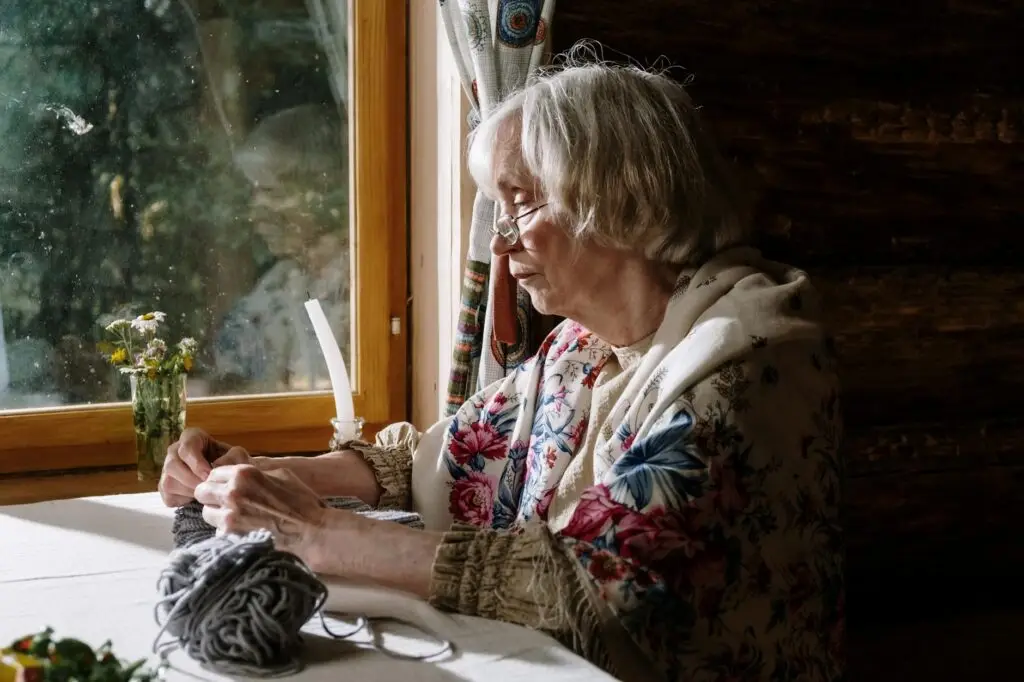Most people consider retirement a time to slow down, not start a knitting business after retirement. But for Susan, a retired nurse with a lifelong love for knitting, it became the start of something big. She turned her passion into a thriving online yarn shop, building a six-figure business from her living room.
Susan’s story matters for anyone over 50 who is wondering what’s possible next. Her journey proves you can turn a long-time hobby into real income and purpose—even if you’ve never owned a business.
In this post, you’ll see how she made the switch, her key steps, and the fundamental strategies behind her growth. Expect tips you can use yourself, whether you want a side income or a brand-new start after retirement.
The Early Days: Passion Meets Opportunity

Retirement can be a huge change, but sometimes it’s the open door we need. For Susan, her first year away from her busy nursing job felt freeing and disorienting. Yet as caregiving routines slipped away, she picked up her knitting needles and found herself drawn back to the calming rhythm of yarn and wool. What started as a simple way to fill afternoons soon became the seed of something bigger to blend her love of people with her creative side.
From Hospital Halls to Yarn and Needles
Decades as a nurse meant Susan was always moving. Shifts ran long, and days were filled with caring for others. Knitting started as her escape on a quiet evening, a soft distraction from stress at the hospital.
Steady from years of patient care, her hands began to stitch row after row. Friends and family got hand-knit scarves and hats for birthdays and holidays. Each project reminded her that her skills could bring comfort differently.
Taking the First Steps Toward a Business
Retirement made her slow down and look inward. With extra time, she knitted more and ended up with piles of finished projects. Neighbors noticed her colorful work and asked to buy gifts for their grandkids or church raffles. Susan realized that what brought her joy could serve others and bring in some extra money.
She dabbled in her first sales at the local farmer’s market. It was simple: a table, a handwritten sign, and a handful of baby blankets and mittens. She was nervous, but the smiles and stories from fellow knitters were just what she needed. After her first sale, Susan returned home energized and hopeful.
Starting small can relieve the pressure if you’re considering selling what you make. You don’t need a whole store or fancy branding, just a handful of items and a willingness to share your story are enough. As the small wins stacked up, Susan decided to learn more about how people turn hobbies like knitting into part-time income. Stories like these, real-life examples from Investopedia, inspired her to keep going.
Overcoming Early Roadblocks
Of course, starting wasn’t always smooth. Susan ran out of change on the first market day after her third sale. She also realized pricing her work felt awkward, putting a dollar value on something made with love is hard.
She joined a local craft group where others were also figuring it out. They traded tips about what sold best at markets, how to chat with customers, and which online shops offered free listings. Early sales were modest, but the support helped Susan push past doubts.
For many retirees, the hardest part is treating a passion like a business. But as soon as Susan saw a neighbor’s baby bundled in her blanket at the grocery store, it all felt real. The reward wasn’t just dollars, it was knowing her work held meaning for someone else.
Motivation: More Than Just Money
Susan’s first steps toward building a knitting business were about more than income. After giving so much in her nursing career, she found real purpose in creating and sharing her work. She now had something to jump out of bed for—new patterns to try, fairs to visit, neighbors to surprise.
For those considering a similar path, Susan’s story shows that mixing passion with purpose is possible, even if the road begins with a single mitten at a community table. For more tips and honest stories about changing direction after 50, check out this guide on how to make money in retirement from Business.com.
Turning Point: Going Online
The hustle and small wins of local markets felt terrific, but it didn’t take long for Susan to realize that her knitting business had bigger potential. She wanted more freedom to reach knitters and gift shoppers beyond her hometown. Moving online was a leap—she had never run a website, set up digital payments, or tracked sales in an app. But the idea of earning extra income while working flexible hours from home sparked new excitement.
Why the Switch to Online?
Susan loved chatting at the farmer’s market, but weekends spent packing up gear and lugging boxes started wearing her out. Online sales offered:
- Rest for her body instead of standing all day.
- Endless reach: customers from distant states could find her handmade scarves.
- 24/7 sales: her shop could bring in money while she had tea with friends or visited family.
She read stories like this guide to starting an online business after retirement, and noticed more retirees were selling their skills and goods with just a phone and an internet connection.
Choosing the Right Platform
Susan’s tech experience was limited to email and the occasional Facebook scroll. She wanted something easy to use, affordable, and friendly to beginners. She narrowed it down to:
- Etsy: Already popular with knitters and crafters.
- Shopify: Good for personal branding, but it has monthly costs.
- Facebook Marketplace: Great for local buyers, but less privacy.
She started with Etsy because it handled most complex parts: listing products, collecting payments, and even some marketing. All she needed to do was take good photos and write honest descriptions.
Early Struggles: Building an Audience and Setting Prices
Getting found online is more complex than putting up a sign at the local fair. Susan had to learn to:
- Use tags and keywords so shoppers searching “handmade baby blanket” or “soft wool hat” find her shop.
- Take bright, clear photos that show off her colors and patterns.
- Respond quickly to messages from buyers, and she soon learned that friendly service led to repeat business.
Pricing was one of her biggest headaches. She didn’t want to shortchange her time, but also needed prices that shoppers would pay. She tried:
- Checking what other knitters charged for similar items.
- Calculating her material costs and adding fair wages for her time (about $10-$12 per hour at first).
- Offering small items—like mug cozies or tiny toys—to get her first sales and reviews.
She would tweak prices every few weeks until sales picked up. The feedback from her first buyers taught her what worked.
Practical Steps That Led to Her First $1,000 Online
Susan’s early milestones weren’t luck—they were built on simple, repeatable actions:
- Posting new products regularly, even once a week, kept her shop active in searches.
- Bundling deals—she’d offer a set of matching hats and mittens at a slight discount to tempt larger purchases.
- Sharing her story—writing about her retirement journey and love for knitting made her shop personal, and people felt connected to her work.
- Joining online groups—knitting forums and Facebook groups helped her swap tips and spread the word about her shop (without spamming).
- Using customer reviews—she politely asked every happy customer to leave a review. Good reviews boosted her credibility and brought more buyers.
Within months, she saw her first $1,000 in online sales. Each new customer lifted her confidence and kept her knitting fun. For more inspiration and ideas tailored to retirees taking their businesses online, you might find the insights at ZenBusiness on starting a business in retirement helpful.
Susan’s willingness to try something new in her sixties proves that your experience pays off when you launch your own venture. For more on why retirement can be the perfect time to start an online business, see these compelling reasons from Medium.
Reviewing this short read on Why Traditional Retirement is Outdated, you can learn more about why traditional retirement ideas are changing—and why online businesses fit so well.
Building a Brand Customers Love
Building a knitting brand that people genuinely love doesn’t happen by accident. It starts with sharing your story, getting clear on what makes your work special, and connecting with customers beyond just the sales. Susan’s approach was personal and genuine from day one, shaping every part of her business around her beliefs, style, and the connections she wanted to foster.
Finding a Unique Position in the Market
Susan didn’t try to be all things to all people. Instead, she looked at what she did best—cozy, timeless designs inspired by years of caring for others. She chose natural wool and soft colors, focusing on durable comfort for families, babies, and gift-givers.
She made a list of what set her apart:
- Thoughtful, classic patterns that evoked warmth and nostalgia.
- A backstory rooted in nursing and a lifetime of helping others.
- Knitted pieces finished with personal tags and handwritten thank-you notes.
- An unwavering focus on quality over quantity.
By highlighting these traits in every listing and conversation, she became more than “just another Etsy shop”—she offered warmth people could feel in every stitch.
Creating a Memorable Brand and Backstory
Customers remember stories, not just products. Susan’s listings weren’t about generic “hand-knit wool hats.” She wrote about why she chose every color, what inspired her designs, and how knitting helped her feel fulfilled in retirement. Her About page featured a photo of her knitting in her favorite chair, with grandkids’ drawings pinned to the wall.
She used a simple but elegant logo—a skein of yarn shaped like a heart—and attached a blank tag to each item for buyers to write their own message.

Branding, at its core, is about building trust. You don’t need fancy design skills or a huge marketing budget. Start by sharing a piece of yourself and how your work reflects your values. This approach helps people see the real person behind each item.
Showing Off Quality with Product Presentation
First impressions matter—especially online, where customers can’t touch or feel your work. Susan took care with every photo: natural daylight, a clean background, and close-ups showing the soft textures. She kept product listings short, clear, and personal.
Some ways she made her presentation stand out:
- Clean, uncluttered backgrounds—so the knitting was the star.
- Detailed shots to highlight texture and color nuance.
- Simple props, like a favorite mug or a sleeping baby doll, to show scale and purpose.
- Honest descriptions with care instructions for longevity.
A memorable product image does most of the selling for you. For more guidance on presenting handmade goods online, tips from experienced sellers can be found in this helpful overview of successful Etsy shops.
Fostering Real Community Connections
Susan knew that true loyalty comes from connection. She joined local and national knitting groups, supported others, and joined online forums not to push her products, but to swap stories, offer advice, and celebrate each other’s wins.
She started a simple blog sharing patterns and stories from her nursing days, which helped others relate to her mission. She showed behind-the-scenes glimpses of her process on social media: choosing yarns, fixing mistakes, or packaging up a special order.
Ways she built her community:
- Replying kindly to comments and questions, even those who never bought.
- Encouraging happy customers to tag her in photos or share their project stories.
- Featuring customer testimonials right in her shop—real faces and feedback.
Strong brands grow naturally from trust and genuine connection. For more on turning your experience and personality into a business that stands out after 50, this guide to new retirement businesses offers helpful stories and practical tips.
Scaling Up: From Side Hustle to Six Figures
Susan’s business didn’t hit six figures overnight. She built real momentum by turning her small shop into a well-run, growing company. This meant freeing up her time, finding new ways to connect with buyers, working with creative partners, and rewarding her best customers. A hobby can only become a full-fledged business when you treat smart growth and customer care as top priorities.
Streamlining Operations and Automating Tasks

When Susan’s sales picked up, she realized she couldn’t juggle everything by hand. She brought in simple tools to save time and reduce mistakes:
- Inventory tracking apps helped her manage stock and supplies, so she never ran out of popular yarns or packed the wrong item.
- Shipping integrations: She connected her online shop with shipping services, printing labels, and tracking packages with a few clicks.
- Order management systems: Orders were collected from all channels—Etsy, her website, even Facebook—into one central dashboard.
Susan spent less time on busy work and more time designing new products. Automating routine work made scaling possible. Even a simple spreadsheet or free inventory app can be a huge help when you get more orders than you can remember off the top of your head.
Growing Through Email Marketing and Social Proof
Susan knew staying in touch with her customers would set her business apart. She started a weekly email newsletter. These emails went beyond sales pitches—instead, she shared:
- New knitting patterns
- Seasonal color trends
- Quick stories about memorable customers or favorite projects
- Limited-time offers for subscribers
This helped her build absolute trust. Her open rates soared, and subscribers often wrote back with questions or pictures of their projects. She also featured five-star reviews and glowing testimonials in her emails and store, which nudged new buyers to trust her shop.
Regular communication kept Susan’s brand top-of-mind. Every thank-you note, story, and customer photo in her marketing materials added a real touch. For creative email ideas that turn subscribers into loyal fans, consider examples from Mailchimp’s email marketing tips.
Collaborating With Influencers and Creatives
Susan didn’t grow her audience alone. Once she had a steady stream of orders, she reached out to others in the knitting and maker communities. She:
- Partnered with designers for limited-edition patterns, which she offered with yarn bundles.
- Sent free products to a few handpicked Instagram influencers known for sharing cozy lifestyle content.
- Linked up with other local business owners—like a nearby tea shop—to create gift baskets for holiday campaigns.
These partnerships exposed her products to new eyes and added instant trust. Even a single kind word from a favorite blogger or designer gave Susan’s business a noticeable boost in traffic and sales. Working together with others helped her shop feel larger and more trustworthy—proof that creative teamwork pays off.
Promotions and Customer Loyalty Programs
Susan focuses on promotions and loyalty to turn first-time buyers into repeat fans. She set up:
- Seasonal sales: Special deals for Mother’s Day, holiday gifts, and “back to school” cozy knits.
- Flash sales: Limited two-day discounts for slow-moving products.
- Thank you codes: After every purchase, she emailed a thank-you and a discount code for next time.
Susan later launched a straightforward loyalty program: After five purchases, customers got a free mug cozy or a $10 shop credit. She also featured customer stories in her newsletter, making shoppers feel noticed and appreciated. Well-timed offers and rewards turned her best buyers into brand cheerleaders.
To grow a business past the side hustle stage, you don’t just want transactions, you want relationships. Promotions and loyalty programs create lasting bonds and encourage word-of-mouth, which any handmade business needs to thrive. For inspiration on rewarding and retaining your best customers, check out the ideas in this guide to building loyalty programs.
Lessons Learned and Advice for Aspiring Entrepreneurs
Running a knitting business after retirement opens new doors—some with bright surprises, others with lessons that stick. Whether you want a side income or a second act, it helps to know the best moves before you start. Here are honest insights and practical advice for anyone over 50 hoping to turn a passion into a business.

Common Mistakes to Avoid
Even if you bring years of life experience, starting a business still comes with surprises. These are a few missteps most first-timers want to dodge:
- Spending too much up front: You don’t need a complete workshop or fancy branding immediately. Start small and keep your initial costs low.
- Mixing business and retirement funds: Never risk your nest egg on a guess. Keep your retirement savings separate from any business investments. Retirees make this mistake often—take it from the experts at Forbes, who share 7 major mistakes retirees make when starting a side hustle.
- Trying to do everything alone: Don’t be afraid to ask questions, join groups, and seek guidance. The community can be your most significant support.
- Ignoring the need for a plan: Even simple businesses need transparent pricing, product ideas, and an understanding of who you’re selling to.
Learning the basics helps you avoid stress and focus on what matters.
Balancing Passion and Profit
Loving what you do makes work feel less like a job, but every business needs to earn enough to be worthwhile. Finding that balance is key.
- Set fair prices: Consider your time, materials, and effort. Charge what your work is worth—don’t undersell yourself out of guilt or fear. Read how one small business owner found her “sweet spot” between passion and healthy profit in this insightful overview.
- Don’t lose the joy: Slow down if knitting starts to feel like drudgery. Limit special orders or only sell what you truly love to make.
- Track everything: Know your numbers so you don’t run a charity by accident. Be friendly, but treat your business side seriously.
Let your passion fuel you, but let your head guide your decisions.
Customer Service Secrets for Handmade Success
In a knitting business, people buy more than scarves and hats—they buy your story, attention, and care. Good customer service sets you apart.
- Welcome every buyer: Send a thank-you note or warm message after every sale.
- Respond quickly: Reply politely, whether it’s a question, complaint, or compliment. Quick communication builds trust.
- Ask for feedback: Invite satisfied customers to leave reviews. Positive testimonials help bring in new buyers.
- Build relationships: Remember names, celebrate return customers, and treat every project like it matters—because it does.
There’s more to pleasing buyers than just shipping on time. For five must-know tips straight from handmade business owners, see this collection of customer service advice.
What I Wish I Knew Before Starting
Looking back, there are lessons only experience can teach. Here’s what people often wish they knew sooner:
- Not every product will sell: Expect a learning curve. Some items will flop. That’s normal. Focus on your bestsellers.
- Community matters: Connecting with other makers in person and online keeps you motivated and helps you learn faster.
- Momentum builds: The effort you put in now pays off later. Small wins add up.
- Ask for help: From tech support to tax prep, don’t do it alone.
- Set boundaries: It’s easy to say yes to every request, but don’t let business drain your fun or your energy.
For those curious about starting a business after 50, guidance from Wolters Kluwer’s tips for entrepreneurship after 50 drives home these takeaways: be thoughtful, stay organized, and don’t rush.
You’ll find even more practical wisdom for late-life business ownership in this internal post, How To Turn Your Passion Into a Profitable Business, with real-world stories that speak directly to reinventing your next chapter.
Frequently Asked Questions About Starting a Knitting Business After Retirement
Many retirees have questions about how to turn their knitting skills into a profitable side hustle—or even a full-time business. If you’re wondering how someone like Susan grew her hobby into a six-figure brand, or if you’re curious about choosing a platform, setting prices, or finding customers, you’re not alone. Here are answers to the most common questions, based on real experience and honest advice.
How Long Does It Take to Build a Six-Figure Knitting Business?
Growing a six-figure business doesn’t happen in a few weekends. For most, reaching that milestone takes at least two to three years of steady effort.
- Year 1: Focus on building a product line, making sales at local markets, and learning the ropes of online shops.
- Year 2: Grow your online presence, develop loyal customers, and expand your marketing—this is when momentum starts to build.
- Year 3+: Many see real gains with consistent effort, good customer service, and smart inventory management.
Everyone’s journey is different, and hitting six figures depends on factors like product uniqueness, pricing, and how much time you invest. If you want more details about turning hobbies into businesses after retirement, visit this guide on how to turn your hobby into a post-retirement side business.
What Are the Best Platforms for Selling Handmade Knits?
Using platforms trusted by buyers looking for handmade and unique products is smart. The most popular options for knitters include:
- Etsy: Known for handmade and vintage. User-friendly and significant buyer traffic.
- Amazon Handmade: Huge audience, but strict application process.
- Big Cartel: Perfect for small shops, with fewer fees.
- Facebook Marketplace: Great for local orders, but less privacy and control.
If you’re just starting, Etsy is often the easiest way to test your products with a broad audience. Read this up-to-date overview of the best online marketplaces to sell crafts and art for a full breakdown of pros and cons.

What’s the Smartest Way to Set Prices?
Setting prices for your handmade items can be daunting for even confident knitters. Keep it simple: cover your costs, pay yourself fairly for your time, and add a reasonable markup.
A common formula:
- Materials + Your Time = Item Cost
- Item Cost x 2 to 2.5 = Wholesale Price
- Wholesale Price x 2 = Retail Price
Check similar Etsy listings, but don’t copy—your time is valuable. For more help, see this straightforward guide to pricing handmade items effectively.
What Were the Major Marketing Wins for Growing the Business?
- Starting a newsletter: Direct emails with stories, pattern ideas, and exclusive offers.
- Bundled deals: Offering sets (like hat + scarf) brought in bigger orders.
- Happy customer photos: Publishing real user photos and short reviews boosted trust.
- Community support: Sharing stories in knitting groups or featuring customer projects made the business feel personal.
- Seasonal promos: Timed discounts for holidays or back-to-school pushed up sales.
For tips from other small business owners who found marketing success with handmade goods, look at these real-life marketing lessons from handmade business owners.
If you want to dive into marketing ideas for solopreneurs over 50, see this post on turning your retirement hobby into a personal brand.
Does Susan Knit Every Product Herself?
At first, yes—every single item came off her own needles. As sales grew, she started working in batches and set clear limits on order numbers. Some knitters eventually take on help or collaborate with other makers, but many keep things personal to maintain quality. The key is to know when to say no and protect your love for knitting.
How Do You Keep Finding New Customers?
Finding new buyers is a constant effort. Here are proven ways to keep sales flowing:
- Keep online listings fresh; add new products and update photos.
- Join online knitting groups to sell and share helpful advice and build authentic relationships.
- Collect and share reviews. Potential buyers trust the opinions of others.
- Hold giveaways or contests on social media—people love to share with friends.
- Sell at local fairs or pop-up events to reach neighbors and word-of-mouth shoppers.
For more strategies to find your next customers, this roundup on getting more customers for your handmade business gives actionable steps.
Inspired by Susan’s story? She’s one of many retirees who’ve reignited their passions in unexpected and powerful ways. If you’re curious how others keep their entrepreneurial spark alive after 50, don’t miss our feature: How Successful Retirees Keep Their Entrepreneurial Spark Alive. You’ll discover the habits, mindsets, and small shifts that help make big dreams possible—at any age.
These answers will help you skip the guesswork and get your knitting business off the ground, or take it to the next level with confidence.
Conclusion
Susan’s journey proves that retirement isn’t just an ending but the start of new chances. She built her knitting business from a simple hobby into something meaningful and profitable, showing that experience and community matter more than age.
If you’re over 50 and dreaming of turning your passion into a small business, start with what you love and build one step at a time. Every scarf, sale, and story can be part of something bigger. There’s so much potential left in your next chapter.
Have you started a business after retirement, or are you considering it? Please share your story in the comments and inspire others in our community. For more ideas on reinventing yourself after work, explore how your next act can be your best one. Thank you for reading—your journey could be the encouragement someone else needs today.









Add comment